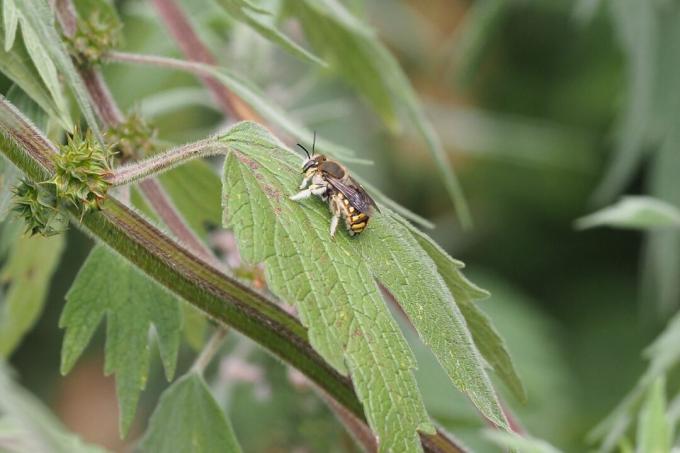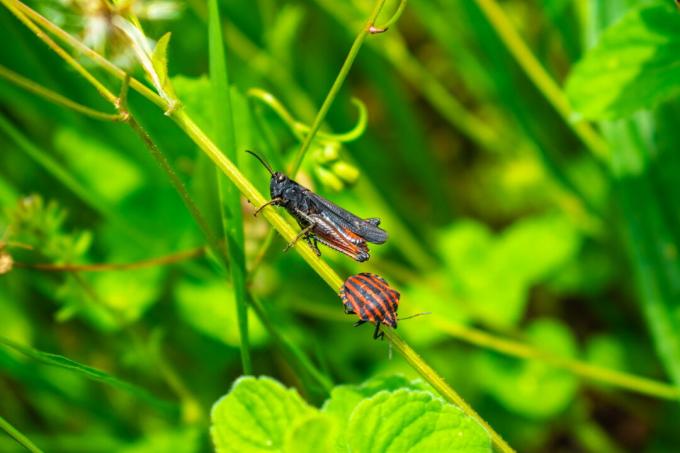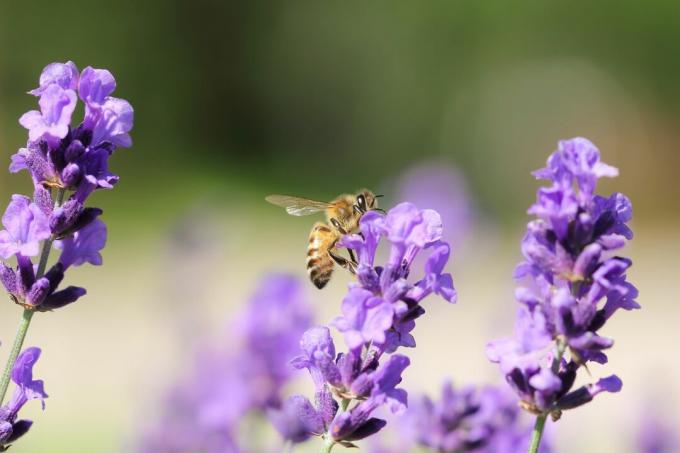Creating a bee pasture with seeds in your own garden is not only good for the environment, but also looks beautiful. Here you can find out what advantages the flower meadow brings with it and which seeds are best suited for a bee pasture.

A flower meadow for bees of all kinds is not only good for the environment: it offers you colorful flowers in a small area with minimal maintenance. There is also a seasonally changing spectacle - from the trouser bee to the blue tit you can observe all sorts of different beneficial insects. You can also help our native insects and pick a bouquet or two. We will show you the advantages and how you can easily transform your garden into a bee paradise.
contents
- What is a bee pasture?
- Benefits of a bee pasture
- Buying bee pasture: the right seeds
- Create a bee pasture: This is how you do it
- Bee pasture in winter
What is a bee pasture?
The term bee pasture has two meanings:
- A plant that gives bees a lot of food in the form of pollen or nectar is, in beekeepers' language, a bee pasture.
- An area on which a particularly large number of bee-friendly plants grow is colloquially called a bee pasture.
On bee-friendly planted areas, bees (Apiformes) of different families, genera and species find food all year round and maybe also one or the other nesting or resting place. Bee pastures are left alone most of the year, allowing nature to take care of itself on this small piece of ground. Even in small gardens, a small area with knee-high bee forage plants can be created.

Tip: Examples of particularly good bee pastures - in the classic sense of the word - are bee-friendly shrubs and stone fruits. But also bee friendly flowers, bee-friendly perennials or bee friendly herbs are important food sources for bees.
Benefits of a bee pasture
What are the advantages of creating a bee pasture? The planting or sowing of bee nutritive shrubs has positive effects not only for the bees. You yourself can benefit from the great ornamental value of bee pastures. Because pollen and nectar are found in flowers - and these are usually brightly colored and often smell wonderful. They possess these traits to attract the attention of bees and other pollinators. In addition, there is hardly anything easier to care for than natural areas full of flowering perennials and summer flowers. Once created, they are cut down with a string mower at most once a year and watered or fertilized a little if necessary.
Tip: Cutting down the faded or withered parts of the plant is also purely optional and serves your own visual requirements. If you leave the area completely to itself, this benefits native insects even more, as hollow stems are retained as nesting sites or building material. Garden birds are also happy about old seed heads and dead stalks.
Creating a bee pasture has these advantages:
- Low maintenance effort
- Enables exciting nature observations for young and old
- High ornamental value all year round
- Habitat for beneficial insects that can protect your garden plants from pests
- Attracts not only bees but also birds and other insects

Buying bee pasture: the right seeds
It doesn't have to be a whole flowering hedge or a bee tree. With the help of a little soil, water and patience, an area with annual and perennial flowering plants for bees and insects can be created with ingeniously composed seed mixtures. With a bit of luck, the annual plants will also seed again, so that the bee pasture will remain attractive to you and various pollinators for many years. But how do you recognize a high-quality mixture for bee pasture?
Seeds for your bee pasture should…
- contain seeds of many different plants, covering diverse flower types and flowering times,
- contain high-quality, germinable seeds,
- contain instructions for correct application and care,
- be developed with experts, for example with beekeepers,
- Provide you with further information on the protection and promotion of bees.
So that you can enjoy your high-quality bee pasture for a long time, we at Plantura have taken these quality features to heart and ours Plantura bee pasture developed. We were supported by beekeepers who advised us on pollen and nectar values, flowering time calendar and bee-friendliness. Overall, we have selected undemanding plants that thrive without much effort. cornflower (Centaurea cyanus), bee friend (Phacelia tanacetifolia) and marigold (Calendula officinalis), but also Adonis (Adonis vernalis) will give you a lot of friends even without a green thumb. If you sprinkle them with some flower fertilizer, such as the Plantura organic flower fertilizer and water, they will bloom magnificently.
Create a bee pasture: This is how you do it
Creating a bee pasture is not particularly difficult. Between April and July you can succeed in investing with the following 4 steps:
- Choosing the right location: Choose an open area (whether in partial shade or in the sun). Our Plantura bee pasture enough for up to 20 m2 Surface. Of course you can also sow the bee pasture in buckets or window boxes.
-
Prepare the surface: Existing vegetation that cannot be integrated into the flower meadow is removed. This gives the new seeds room to develop. This is especially true for lawns. This should be removed in sods or milled. Existing bee-friendly plants can of course be retained.
If the soil is very sandy and poor in nutrients, it is advisable to incorporate something Plantura organic flower fertilizer and the peat-free Plantura organic potting soil. The surface is then raked smooth with a rake. - Sowing: Shake the seed packet well to mix the different seeds. Our Plantura bee pasture contains some coconut material, which makes it even easier to spread. Now spread the seed over the area. The seeds are then covered thinly with soil or raked in flat, pressed and then watered extensively.
- Care for: Regular watering is necessary until the seed emerges and during long periods of drought. In the first year after installation, the area should be walked on as little as possible. Once a year you can use a flower fertilizer like ours to cover the area Plantura organic flower fertilizer fertilize to encourage profuse flowering.
Ours will germinate after about 2 to 4 weeks Plantura bee pasture under normal conditions. You can admire the first flowers after about 8 to 10 weeks. Because the seeds contained are annuals and perennials, the composition of your bee meadow will change over the years change: some seed plants sow themselves, perennials get bigger and maybe one or the other will come Add wild plant.
By the way: Most bees prefer to be in warm, sunny places. Because suitable forage plants have emerged with the respective pollinators in co-evolution, most bee pastures therefore prefer to grow in sunny locations.

Bee pasture in winter
As the year draws to a close, the bee pasture slowly withers. Now it's not time to cut loose, but rather leave the stalks and old seed heads over the winter. These serve as winter quarters for many insects and small mammals. In addition, some annual plants only release their seeds after winter. So that the seed is not lost, it is better to never cut down the insect willow or only cut it down in spring. In this way, you also give hibernators the chance to seed themselves in the spring. When cutting down in the spring, it is worth shaking the clippings vigorously to free any seeds that may still be inside.
Looking to welcome bees and insects throughout your garden? Here you will find many other exciting articles on the subject: How about nesting aids for wild bees? By the way you can find in our shop next to the Plantura bee pasture also seed for one Plantura butterfly meeting and a mixed bag, which we rightly call Plantura beneficial insect magnet describe. All of our seed mixtures can also be spread together to get a particularly wild meadow.
